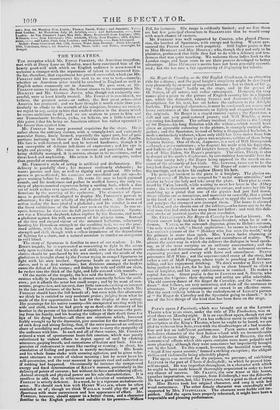Sir Roger de Coverley, or the Old English Gentleman, is
an attraetive title for a drama ; and the good knight's simplicity might be developed very pleasantly by an actor of congenial humour : but to think of Int ing " the Spectator " bodily on. the stage, and in the perztal of 0. SMITH, of all actors, was raAer extravagant. However, the very names give a grace to the picture of English country life in a bygone age, which the dramatist, taking STEELE and A nnisoa's t!elhtful descriptions for his text, has set before the :Judicial: in the Adelphi burhata. The principal characters, it must be confessed; are coarse and heavy caricatures of the lineaments so lightly and elegantly traced in the originals. Sir Roger is a stupid country squire ; the Spectator, a dull and not very good-natured proser ; and Will Whitish', a mere roystering fox-bunter. The solitary incident that enlivens the history of Sir Roger—his long flirtation with the widuw—which would have given an agreeable colouring to the picture, is strangely omitted alto- gether ; and the Spectator, instead of being a disappointed bachelor, is made a melancholy widower, whose only child has been stolen from him in her infancy. Sir Roger is given two nephews, neither of them being Captain Sentry. One of them, Augustus, is a suit of Will Honeycomb —though a gross caricature; who disgusts his uncle with his fopperies, and forfeits all claim to the old knight's favour, by planning the abduc- tion of Miss Helen, Sir Roger's protegee. The other, Henry, is also in danger of his uncle's displeasure, by eta( rtaining honourable love for the same young lady ; Sir Roger being opposed to the match on ac- count of the obscurity of her birth. She, however, turns out to be the lorg-lost daughter of the Spectator : Sir Roger of course consents to the marriage, and makes his nephew Henry his heir.
The prineipal incident in the piece is a burglary. The gipsies en- gaged to cat iy off Helen are tempted by " metal more attractive," and resolve to leal e the lady and take away the plate. Their plan is over- heard by !leen herself, while waiting to meet her lover in the Abbey ruins: she is discovered in attempting to escape, and saves her life by snatching up a pistol that one of the gipsies had just laid down. Stage villains are so incautious, and moreover so cowardly, that a pistol in the hand of a woman is always sufficient to appal the stoutest heart and paralyze the strongest arm amongst them. The house is alarmed by Helen, arid she shoots one of the robbers,—who turns out to be the very man that had stolen her away from her father : and with this
deli- cate stroke of poetical justice the piece concludes.
Mr. CELL EN FORD'S Sir Roger de Couerhy is as hard as hiccory. 0. Simi' cannot help looking like a house-breaker, when he is not a &anon. YATES, as the coxcomb Augustus, gives to Helen's sarcasm, "he may wants a tail," a literal application : he seems to have studied Layoseen's picture of' the " Monkey who has seen the world," only his grimace is more than apish. Mrs. YATES looks charming as Reim ; and her acting has all the ease and naturalness of reality. We admire the quiet way in which she delivers the dialogue in level speak- ing, as if she were carrying on an ordinary conversation; and the collectedness and determination of her manner in vehement scenes— expressing passion and energy with force and smoothness. REEVE personates Moll IF/tile; not the superannuated crone of the story, but rather a sort of Moll Flaggon, whose trade is poaching and fortune- telling, and her enjoyment drinking. We don't wonder at REEVE not being perfect in his part, for he has only to show himself to elicit a roar of laughter, and his very obliviousness is comical. He makes a capital Amazon. Great praise is due to SANDERS and S. SMITH, who personate the Gipsies: their dressing and acting are alike admirable. The old country. dance of Sir Roger de Coverley, and the " cushion- dance " that follows, are very animating, and show off the costumes to advantage. The gipsy encampment at sunset is an effective scene. But the most striking tableau is the embodyment of LESLIE'S picture of " Sir Roger de Coverley and the Spectator going to church: " it is one of the best things of the kind that has been done on the stage.


























 Previous page
Previous page